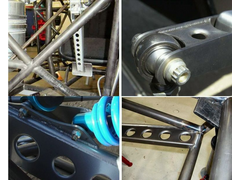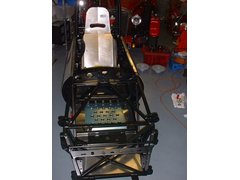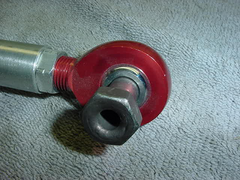JB
|
| posted on 30/9/04 at 05:09 PM |

|
|
Lightening Holes
I have seen many instances of holes being drilled in items such as pedals, chassis members etc.
Do you realise that putting a hole in a part does indeed reduce its weight but also reduces its strength to a very large degree?
Drilling holes in a brake pedal is very dangerous (not the foot pad but the actual upright part).
Drilling holes shows lack of understanding.
A better way of making a part lighter is to reduce the material from where it is not required. This generally means having more material around areas
of high stress. So where it joins something else it will be thicker. Around a fixing hole it will be thicker etc.
Its all about reducing stress raisers and having smooth transitions between different sizes.
I hope this helps,
John.
|
|
|
|
|
stephen_gusterson
|
| posted on 30/9/04 at 05:37 PM |

|
|
where?
ive never seen that on this forum?
atb
steve
|
|
|
stressy
|
| posted on 30/9/04 at 05:56 PM |

|
|
John,
I haev seen examples of drilling standard part elsewhere resulting in failure, this is a BAD idea.
However, if your talking about making new parts i think youll find it all comes down to tools and money!!!
Cheers
Chris
WHO DARES SPINS
|
|
|
Jon Ison
|
| posted on 30/9/04 at 06:23 PM |

|
|
no comment, now where did i put me drill.
|
|
|
Hellfire
|
| posted on 30/9/04 at 08:22 PM |

|
|
JB - total b0llox... you can't lighten a hole - they don't weigh anything 
On the hole I agree with you though...
However, it depends on where, how big the hole is but more importantly whether it has been designed this way. i.e. the material thickness in relation
to the stresses apllied.
I bet Cymtrix and others, could come up with a design to prove the fact.

|
|
|
Hugh Paterson
|
| posted on 30/9/04 at 10:50 PM |

|
|
Feck now he tells us, wheres the bits I drilled oot the Brake pedal, help ma boab, wonder if thats why the brakes are spongy 
Shug.
|
|
|
Hugh Jarce
|
| posted on 1/10/04 at 02:58 AM |

|
|
quote:
Originally posted by JB
Do you realise that putting a hole in a part does indeed reduce its weight but also reduces its strength to a very large degree?
How can you make such a broad sweeping statement as that? Putting holes in items doesn't necessarily reduce the strength and the degree (if any)
of weakness would not necessarilly be "large".
quote:
Originally posted by JB
Drilling holes in a brake pedal is very dangerous (not the foot pad but the actual upright part).
No it's not! Drilling holes in your head could be. There's nothing wrong with lightening parts as long as it's informed and done
sensibly.
quote:
Originally posted by JB
Drilling holes shows lack of understanding.
Bollox! (unless speaking from experience)That statement itself displays ignorance.
quote:
Originally posted by JB
A better way of making a part lighter is to reduce the material from where it is not required. This generally means having more material around areas
of high stress. So where it joins something else it will be thicker. Around a fixing hole it will be thicker etc.
Its all about reducing stress raisers and having smooth transitions between different sizes.
I thought lightening was all about lightening.
If you're going to start threads like this, please show an example or some form of supporting evidence and don't just waffle on in general
terms. It doesn't help others at all.
If you have any practical, helpful information specific to lightening holes, why not type up a short "how to" and post that. 
The pay isn't very good , but the work's hard.
|
|
|
JB
|
| posted on 1/10/04 at 07:11 AM |

|
|
OK, I will work on a brief article with examples, good methods, bad methods, references and further reading on the general subject of stress raisers
and design.
Hugh, you are correct when you say "There's nothing wrong with lightening parts as long as it's informed and done sensibly. "
but drilling holes is not the sensible option.
Check an F1 or WRC and see how many structural parts have lightening holes in them. This should tell you something.
John
|
|
|
David Jenkins
|
| posted on 1/10/04 at 07:50 AM |

|
|
What brought this on anyway?!
I don't recall seeing any life-threatening pictures of lightening holes recently.
The only lightening holes that I do remember were on the back of Terrapin's.. er... Terrapin, and that was a really neat job in a bit of
barely-critical chassis. He even expained how he did them!
Perhaps the most telling thing is the "building" information in JB's profile (i.e. theory, rather than practice).
cheers to the builders,
David
[Edited on 1/10/04 by David Jenkins]
|
|
|
Hugh Jarce
|
| posted on 1/10/04 at 07:53 AM |

|
|
quote:
Originally posted by JB
Check an F1 or WRC and see how many structural parts have lightening holes in them. This should tell you something.
OK, while not F1 or WRC (and neither are Locosts by the way  ), here's a selection of lightening holes in race cars including one lightened
brake pedal. ), here's a selection of lightening holes in race cars including one lightened
brake pedal. 
 
Rescued attachment dimpled_holes01.jpg
The pay isn't very good , but the work's hard.
|
|
|
David Jenkins
|
| posted on 1/10/04 at 07:58 AM |

|
|
I can't/won't comment on the structural integrity of those bits of metal - but that welding is magnificent!

David
|
|
|
leto
|
| posted on 1/10/04 at 08:35 AM |

|
|
Very roughly: To gain the equivalent of 1 hp you have to drill out about 5kg.
Cheers!
“I'm gonna ride around in style
I'm gonna drive everybody wild
'Cause I'll have the only one there is a round”. (J. Cash)
|
|
|
James
|
| posted on 1/10/04 at 08:37 AM |

|
|
JB,
I've drilled out the centres of all my suspension bolts to save weight- is this ok?
Cheers,
James

|
|
|
Hugh Jarce
|
| posted on 1/10/04 at 08:46 AM |

|
|
quote:
Originally posted by leto
Very roughly: To gain the equivalent of 1 hp you have to drill out about 5kg.
Cheers!
It's not all about horse power. Lightening suspension components can lessen unsprung weight. Handling, responsiveness and nimbleness would be
my priorities for lightening parts.
The pay isn't very good , but the work's hard.
|
|
|
timf
|
| posted on 1/10/04 at 09:07 AM |

|
|
quote:
Originally posted by James
JB,
I've drilled out the centres of all my suspension bolts to save weight- is this ok?
Cheers,
James

coping the bike racers then james
|
|
|
JB
|
| posted on 1/10/04 at 09:22 AM |

|
|
You will notice that the holes in most of the pictures are not actually drilled they are punched then swaged. The swaging is very important.
Drilling the centre of bolts is OK as the centre is actually a nuetral axis. However it is a lot of work for a small saving but every little
counts.
I know my profile is a bit vague but I prefer to remain a little anonymous. I have read and understood all of Carroll Smiths books, I have studied
many of Vizards books, I have Millikens / Millikens book (I admit I do not understand it all).
I have been building vehicles for 20 years and I am sure much of my work is known to a lot of you.
JB.
|
|
|
Matthew_1
|
| posted on 1/10/04 at 10:45 AM |

|
|
I tend to agree with Hugh on this. The main problem is the wildly sweeping statements people are making.
E.g. "to gain 1hp you have to loose 5kg", what in 500kg car or a 2000kg car ?
Or, "drilling the centre of bolts is ok" - take a 10mm bolt, and drill out a 9mm hole, is it still ok to hold your wishbones on ?
Drilling holes is just one of a number of methods to make a part lighter, to sweepingly say its a daft idea IS daft. Its just part of the design and
engineering process. If the part has been designed to have sufficient strength to have holes punched in it, then punch holes in it.
I agree mindless hole-drilling is a bad idea, but I don't think anyone here is advocating that ?
|
|
|
MikeR
|
| posted on 1/10/04 at 11:32 AM |

|
|
So whats the difference between drilling a hole and punching and swaging a hole (and why can't you drill and swage a hole)?
This isn't intended to be inflametory, i'm just curious as to what swaging does.
|
|
|
David Jenkins
|
| posted on 1/10/04 at 11:53 AM |

|
|
John,
Apologies for calling you a 'theorist, not a builder' - but your opening statements seemed to talk down to everyone, with a
lecturing/'I know best' tone. Perhaps a "Do people think that drilling holes is risky..." approach wouldn't have got
peoples' backs up so quickly. The fact that no-one had been discussing or advocating lightening holes lately didn't help either!
As for anonymity - being provocative and anonymous makes people think that you are a troublemaker trolling for an argument! Now, I don't think
that you are... are you? 
Perhaps we can all start again from the beginning...
rgds,
David
|
|
|
Bob C
|
| posted on 1/10/04 at 12:18 PM |

|
|
wildly sweeping statements
E.g. "to gain 1hp you have to loose 5kg", what in 500kg car or a 2000kg car ?
actually it's only dependent on what speed you're doing.....
Bob C
PS and I'm probably wrong.......
|
|
|
JB
|
| posted on 1/10/04 at 12:19 PM |

|
|
Sorry I did not mean to offend anyone or spoiling for an argument. I am just trying to pass on my car building experience.
Hopefully I will get an article together tonight which will better explain what I mean.
A drilled and swaged hole will be as good. The tools I have seen punch and swage the hole in one go.
JB
|
|
|
Matthew_1
|
| posted on 1/10/04 at 12:45 PM |

|
|
Having read the thread it does seem more like it should have been started "listen folks, don't just start drilling holes in things to
lighten them", rather than "drilling holes to lighten is bad".
|
|
|
Terrapin_racing
|
| posted on 1/10/04 at 12:58 PM |

|
|
Regardless of the "politics" this is a very interesting topic. Liked James's bolts - did you know that Allan Staniforth's
colleague Richard Blackmore drilled the centre out of every single bolt on his Terrapin racecar (early 1970's) in order to save a few lbs ?
Years late the car was only identified by this fact. No know failures - just to re-assure you.
I'd be interested if anyone knows of a source of reasonable cost swaging tools?
I have always ended up making them because the ones I have seen (aircraft tool supplies) cost a fortune.
Cheers
Rob
 
Rescued attachment Terrapinchassisbare.jpg
|
|
|
Hugh Jarce
|
| posted on 1/10/04 at 01:27 PM |

|
|
quote:
Originally posted by JB
You will notice that the holes in most of the pictures are not actually drilled they are punched then swaged. The swaging is very important.
Drilling the centre of bolts is OK as the centre is actually a nuetral axis. However it is a lot of work for a small saving but every little
counts.
I know my profile is a bit vague but I prefer to remain a little anonymous. I have read and understood all of Carroll Smiths books, I have studied
many of Vizards books, I have Millikens / Millikens book (I admit I do not understand it all).
I have been building vehicles for 20 years and I am sure much of my work is known to a lot of you.
JB.
Granted, the majority of the holes in those photos are swaged, which goes to support my submission that all holes are not bad. Swaging a hole often
leaves a part stronger than if it had not been holed.
The brake pedal, interestingly enough, is laser cut and folded - with out swaging or any loss in strength.
JB, you are perfectly entitled to remain anonymous, but if you do, don't expect to be taken seriously without substantiating your every comment.
I repeat: it does you no good to blurt out like that, but more importantly, it is detrimental to this knowledge base.
If you have indeed got 20 years experience in car building, then you could be a great asset to this forum.
Either put up or shut up.
Bolts are dificult to drill concentrically (at least, anything over 25mm long), and if high tensile, and in a highly stressed location, they should
really be internally honed to reduce the possibility of stress risers.
I have used both hollow bar and thick walled chrome moly tube for making various fasteners from. I thread both ends: the "head" has only
enough threads to fully engage a nut which is then rose-welded from the top.
I always replace the long engine mounting bolts with these when mounting a motorbike engine. They are also perfect for any double shear suspension
pivot bolts.
 
Rescued attachment hollow_bolt.jpg
The pay isn't very good , but the work's hard.
|
|
|
derf
|
| posted on 1/10/04 at 02:24 PM |

|
|
Personally I believe that things should be overbuilt. In the case of drilling a hole, it should be swaggered, not just cut out. I have seen many
people drill out bolts, and for my personal feelings I would never drill one out. I have seen too many bols sheer, and it scares me that there is a
hole in one. I have no scientific data to back up my "cautiousness", but the little bit you save in weight from drilling out a bolt is
almost negligable, and even if you drill 100 bolts and save 10 pounds I dont believe it is worth it.
|
|
|









